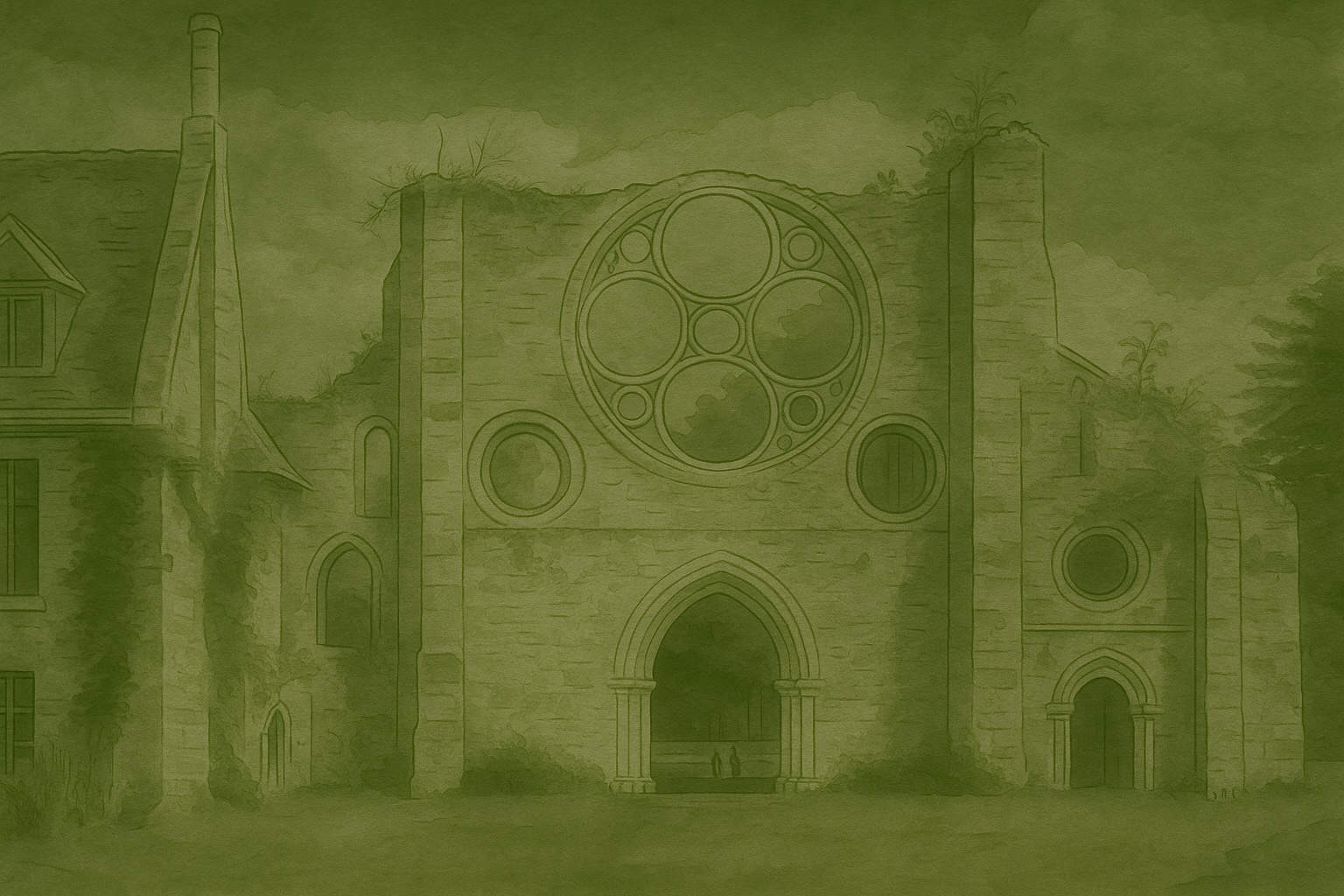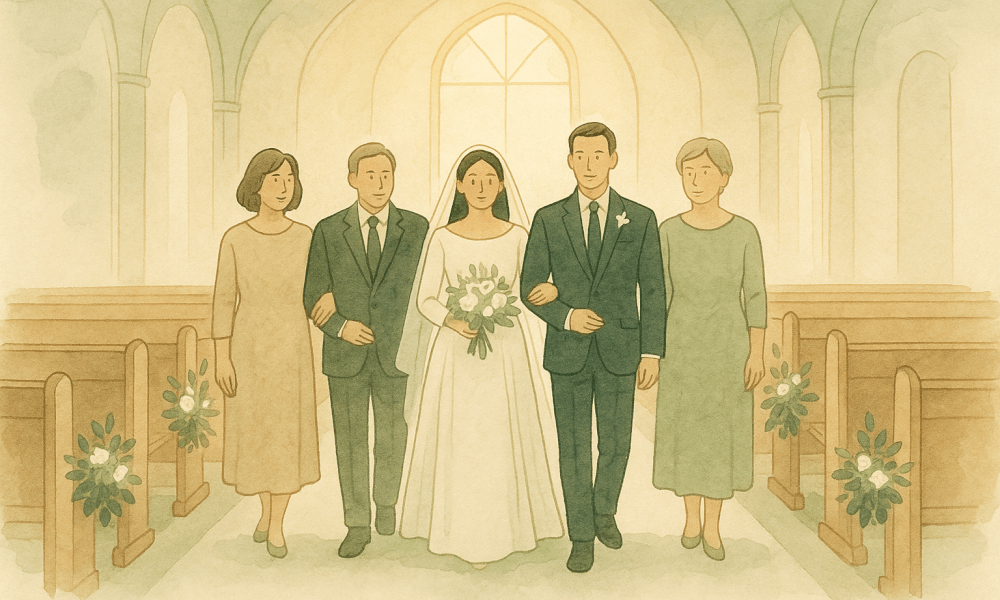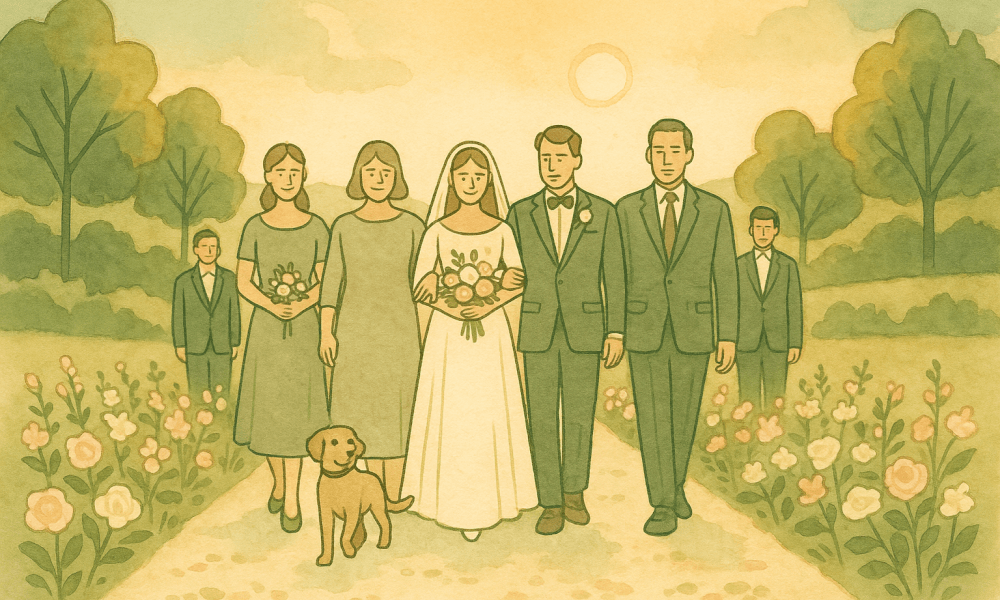Wedding Procession: 4 Key Steps for an Unforgettable Walk Down the Aisle

Organizing a wedding procession is much more than arranging a simple parade: it’s creating a moment of pure emotion that sets the tone for your entire ceremony. Between cherished traditions and personal touches, this procession embodies the love you share and the affection your loved ones have for you. Whether you dream of a solemn processional down the aisle at church or a freer, non-religious procession, every detail — from participants to music to attire — can turn this entrance into an unforgettable moment. In this article, we kindly guide you through the key steps, the rules, and the inspirations to design a harmonious and authentic staging true to your story.
To better understand this foundational moment, a few reference points are needed.
The basics of the wedding procession
The wedding procession is much more than a simple nuptial parade. This age-old tradition is a formal wedding march that accompanies the couple toward the altar, symbolizing the transition into a new life together. The procession embodies shared joy and the moral support of loved ones at this pivotal moment of the union. Made up of parents, junior attendants, bridesmaids and groomsmen, and the wedding witnesses, each member has a specific symbolic role in this traditional wedding procession. The groom usually leads the processional on his mother’s arm. The junior attendants precede the bride, bringing innocence and tenderness by carrying the rings or scattering petals. The couple’s entrance traditionally concludes with the bride on her father’s arm, symbolically marking the handover from parental guardianship to married life.
Organizing the wedding procession follows precise codes during a religious ceremony. The protocol for the church procession begins with arranging the procession: procession members are seated first and stand when the procession arrives. The groom enters on his mother’s arm, then positions himself at the altar according to traditional church procession placement.
The groom’s father then accompanies the bride’s mother, illustrating the union of the two families by this symbolic accompaniment of the couple. The witnesses and the wedding party often proceed in pairs, respecting the established order of the wedding procession. The junior attendants, including the ring bearer and the flower girl, walk just before the bride. She makes her entrance on her father’s right arm, moving toward the altar to stand to the left of the groom. Children may carry her train if necessary, thus participating in the role of the wedding procession.
For a non-religious or civil ceremony, the order of the wedding procession becomes much more flexible and customizable. The couple can adapt the procession protocol to their wishes, unlike religious ceremonies that follow strict rules. They may choose to enter hand in hand or separately according to their preferences.
The groom often enters first, followed by the procession made up of witnesses and bridesmaids, then the bride with or without accompaniment. At the town hall, the protocol remains simple: the couple usually arrive together or separately, sometimes in a motorcade, accompanied only by their witnesses. The couple’s car can even be an integral part of the staging. The mayor welcomes them for the official ceremony without a complex ritualization of the procession. This freedom allows couples to create an entrance that truly reflects them, later immortalized in photos of the wedding procession.
The traditional composition of the wedding procession, according to the classic definition, revolves around several key participants. The attire and styling of the wedding procession should be coordinated to create visual harmony, particularly visible in photos of the wedding procession:
- The couple form the heart of the ceremony: the groom arriving on his mother’s arm while the bride enters on her father’s arm
- The parents symbolize the union of the families, the groom’s father accompanying the bride’s mother according to tradition
- The witnesses (at least two for a civil ceremony, up to four for a church ceremony) serve a legal and emotional role, signing the papers and supporting the couple
- The bridesmaids and groomsmen, close friends often single, assist the couple throughout the day
- Help with preparation and dressing
- Manage the train and the bouquet
- Coordinate guest reception
- The junior attendants (generally ages 3 to 10) bring freshness and innocence
- Carry the rings on a cushion
- Scatter flower petals
- Hold the dress train
It’s worth noting that the Jewish wedding procession follows specific traditions, where both parents generally accompany each spouse under the chuppah, symbolizing the importance of family in this sacred union.
With these reference points in place, it’s time to move on to the practical organization for the big day.

How to organize your wedding procession?
Logistics: rehearsal, timing, positioning
Meticulous planning of the wedding procession transforms your nuptial parade into a memorable moment. Schedule rehearsals several weeks before the wedding day, ideally at the ceremony venue. Gather the witnesses, junior attendants, parents, and officiant to clarify the procession order and the pace of the wedding march.
Set a precise timeline: gathering times, procession departure, exact sequence with a buffer for unexpected delays. Arranging the procession requires particular attention to seating arrangements. Place cards or a designated usher will help guide each participant to their position in the church procession.
Coordinate transportation and the motorcade according to your locations and schedule. Plan a friendly moment after the rehearsal to finalize the procession protocol details with the main participants.
To make this plan operational, a concise checklist helps streamline each step.
Practical checklist for organizing the wedding procession
Careful preparation ensures a harmonious traditional wedding procession on the big day.
- Define the composition of the procession - Select parents, witnesses, junior attendants and bridesmaids according to your family and friendship ties, while respecting the balance of the desired wedding party
- Establish the entrance order - Decide who enters first in your wedding parade: junior attendants, groom on his mother’s arm, witnesses, then the couple with the bride on her father’s arm
- Assign specific roles - Explain each participant’s role in the procession: carrying the rings, supporting the bride, leading the procession
- Organize a rehearsal - Schedule practice time to check movements, distances and the synchronization of the couple’s accompaniment
- Appoint a coordinator - Designate someone responsible for managing arrivals, reminding roles and organizing the queues
- Communicate times and details - Send a summary sheet with times, procession order, accessories and attire for the procession
- Prepare accessories - List bouquet, ring cushion, flower baskets according to the procession’s styling
- Adapt to the venue - Check aisle width, distances and obstacles to adjust the organization, especially for a church procession
Beyond tasks, the human aspect deserves special attention.
Practical advice: how to choose procession members, handle conflicts or cancellations
Human relationships shape the success of the wedding procession according to its traditional definition. Choose close people you trust, who are available for preparations and the ceremony. Prioritize emotional closeness rather than social obligation when selecting bridesmaids and witnesses.
When conflicts arise, use active listening and remain neutral. Work together toward mutually agreeable solutions to maintain harmony in the procession, whether it’s a Jewish or traditional ceremony based on your beliefs. Identify tensions early so you can intervene promptly.
For cancellations, choose your members well in advance. Communicate their responsibilities clearly in the nuptial procession. Prepare alternatives: a cousin can replace an unavailable friend. Flexibility turns obstacles into opportunities for a successful wedding procession photo.
Etiquette also frames the ceremony while allowing room for flexibility.

Manners and protocol related to the procession
- Traditional entrance order: Junior attendants open the procession, followed by the bridesmaids. The groom enters on his mother’s arm who accompanies him to the altar. The witnesses and parents follow. The bride always closes the procession, on her father’s arm for the couple’s entrance
- Assigned seating: Parents and witnesses occupy the front rows, junior attendants up front. Each member knows their exact place in the church procession thanks to the prior rehearsal
- Respect for guests: Guests are seated before the wedding party and stand when the processional passes. The first rows are reserved for close family
- Advance communication: Inform each participant of their procession role and seating. An on-site rehearsal ensures the flow of the procession
- Day-of coordination: A designated person manages the procession protocol, checks everyone’s presence and maintains the established order. The couple’s car should be ready for departure
- Reverse exit: The couple exits first, followed by the bridesmaids and parents, creating a visually balanced procession as the newlyweds are escorted to the getaway car
With this framework set, think about the staging to enhance the moment.
Staging your wedding procession
Staging the procession during the couple’s entrance and the ceremony exit
Once the composition of your wedding procession is defined, it’s time for the choreography of the key moments. The traditional order usually begins with the groom on his mother’s arm, followed by the groom’s father with the bride’s mother. Junior attendants then lead the way for the bridesmaids and groomsmen. The witnesses precede the bride, who enters on her father’s arm, thus marking the couple’s accompaniment toward their new life. This nuptial procession symbolizes the joining of the two families.
The pace of the wedding march should match the music chosen to avoid a scattered procession. Plan a full rehearsal to smooth transitions and perfect the procession’s staging, especially in tight spaces like church doorways or staircases. The positioning of the procession in the church generally follows an established protocol.
The exit is performed in reverse order, creating a harmonious wedding parade where the newlyweds leave the ceremony last to be greeted by their guests. Depending on customs, the exit can also begin with the couple at the front to form an honor aisle.
On this basis, modern personalizations offer lovely variations.
Modern adaptations and possible personalizations of the wedding party
The organization of the wedding procession is evolving toward tailor-made compositions that reflect the couple’s personality. In a Jewish wedding procession, for example, both parents traditionally accompany each spouse. Groomsmen can escort the bride while bridesmaids accompany the groom, favoring personal affinity over gender. A mismatched wedding party replaces uniformity: each person wears a personalized outfit balanced by a shared color palette or a signature accessory like colorful socks. Styling for the wedding party favors bright tones (coral, electric blue) alongside natural shades (terracotta, champagne). Some couples make their entrance together, redefining the traditional procession and symbolizing equality in their commitment. Pets are also being included in the procession as ring bearers, taking on a genuine role in the wedding party. These adaptations allow you to create a unique procession aligned with your values.
Music then sculpts the emotion of these moments.
Which music to choose for the procession?
Q: How should I choose the ideal music for my wedding procession?
R: First distinguish the procession’s entrance from the bride’s arrival, as they can have different music. For a classic ceremony respecting procession protocol, Mendelssohn’s “Wedding March” or Jeff Buckley’s “Hallelujah” create a solemn atmosphere. Contemporary ceremonies favor Bruno Mars’ “Marry You” or Pharrell Williams’ “Happy” to energize the couple’s entrance.
Q: How long should the music be?
R: The music should precisely cover the length of the procession to avoid awkward dead air. Time your route during rehearsal to adjust the duration perfectly.
Q: Can styles be mixed?
R: Absolutely. Vary the moods: festive for the procession entrance with Magic System’s “Magic in the Air,” romantic for the bride’s arrival with Christina Perri’s “A Thousand Years.” The essential thing is coherence with your theme and personal tastes.

The visual atmosphere completes the mood of your entrance.
Decoration and accessory ideas for the procession
To visually enhance your wedding procession, several decorative elements are available:
- Floral decoration: Create arrangements for the couple’s car (compositions on door handles and mirrors), dried or fresh flower crowns for bridesmaids, and personalized boutonnieres for the men in the procession.
- Children’s accessories: Outfit the little attendants with floral hair clips, tulle tutus, decorated baskets or crowns sized for them. Flower bracelets and shoe bows harmonize their outfits.
- Vehicle ornaments: Dress the cars with ribbons in the wedding colors, “Just Married” signs, or custom stickers. Photos of the procession will immortalize these decorations. Wildflowers suit a rustic style, peonies suit classic romance.
- Ceremony ambiance: Set up a floral arch marking the entrance, decorate chairs with covers and tulle, and add lanterns along the aisle. For an exotic wedding, favor lush greenery and tropical flowers with gold accents that will enhance every photo of the procession.
All that remains is dressing the participants for perfect harmony.
Participants in the procession
Procession attire: advice for children, witnesses, bridesmaids
The visual harmony of the wedding procession rests on thoughtful wardrobe choices to create an elegant nuptial parade. First identify two or three main colors that match your procession’s theme. Bridesmaids can wear flowing linen dresses for a traditional rustic procession or light jumpsuits for a modern ceremony.
Witnesses and groomsmen can coordinate their bow ties with the bridesmaids’ dresses for a cohesive procession look. For junior attendants, favor practical outfits without annoying details that respect the procession protocol. Flower crowns visually unite the entire wedding party. Avoid white to preserve the bride’s exclusivity during the entrance. Start shopping three months ahead, order two months in advance and do final fittings one month before the day for a smooth procession wardrobe plan.
Involving the little ones also requires a few specific considerations.
Tips for involving children in the procession without stress
Coordinated outfits create a beautiful visual unity, but some challenges arise when children are part of the procession. A good solution is to limit their number to six or eight participants aged four to eight in your church procession. Give each child a simple role in the procession: scattering petals during the processional, carrying rings on a personalized cushion, or holding humorous signs like “Daddy, here she comes!” as the couple is escorted.
A rehearsal three months before helps familiarize the children with their placement in the church procession and their route to the couple’s car. On the wedding day, set up a kids’ corner with games and coloring near the procession staging area. A dedicated host watches over this group during the reception. Personalized badges will remind them of their participation in the procession, whether it’s a traditional Jewish or modern wedding. This approach turns their involvement into a joyful moment for a memorable wedding procession photo rather than a source of stress for everyone, thus honoring the very definition of the procession as a collective celebration.
Organizing a wedding procession requires particular attention because this procession reflects the symbolic union of the families and imprints the first emotions of the big day. By combining tradition, personalization and rigorous management, you build more than just a parade: a true emotional signature of your ceremony. Whether you opt for a classic setup in church or a freer entrance in a secular setting, the essence remains the same — highlighting your love surrounded by those who matter. By focusing on rhythm coordination, coordination of attire, smooth movement and involving your loved ones at every step, you turn this moment into an unforgettable memory. So let your creativity speak, attach intention to every detail and bring to life a procession that tells your story with elegance and authenticity.

Weddings


